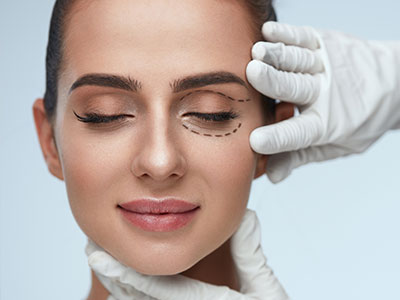
Our Offices
18999 Biscayne Blvd
Suite 101
Aventura, FL 33180
7800 W Oakland Park Blvd
Unit 205, Building B
Sunrise, FL 33351

An oculoplastic surgeon has extensive training in the treatment of a wide variety of diseases of the eyelids, orbit (soft tissues surrounding and behind the eye), and tear drainage system. Conditions treated by these specialists range from sight- or life-threatening cancers to cosmetic or aesthetic in nature. Recent advances in medical and surgical techniques have enabled more precise diagnosis, more effective treatment, and faster recovery for many of these diseases.
South Florida Eye Health is proud to offer comprehensive oculoplastics care. Please call us to schedule your appointment with our oculoplastics specialist.
Dermatochalasis – Excess eyelid skin
Excess eyelid skin may block or obstruct vision, may be of cosmetic concern, or both. Age and genetics are the main determinants of skin stretch, though other medical conditions may be considered. Blepharoplasty, or surgical removal of eyelid skin and/or fat, is a common procedure done to address this issue and is the most common cosmetic procedure done worldwide. Excess lower eyelid skin and fat, commonly referred to as “bags”, can also be addressed in a similar manner.
Eyelid ptosis – Droopy upper eyelid
Like dermatochalasis, eyelid ptosis may affect vision if severe enough, or may primarily be cosmetic in nature. The most common cause of adult ptosis is stretch or detachment of the levator aponeurosis, the main muscle which lifts the upper eyelid, though a complete examination is necessary to rule out other causes. Depending on severity and other factors, surgical repair of eyelid ptosis may be performed from the inside of the eyelid without leaving any external scar.
Ectropion and entropion
Like upper eyelids, lower eyelids over time can become loose with time, which predisposes them to malposition. The lower eyelid turning out (ectropion) or in (entropion) is a frequent contributor to eye redness, irritation, tearing, and can predispose to infection. These conditions in most cases require repair to prevent scarring and other long-term changes on the ocular surface.
Post-blepharoplasty retraction
Lower eyelid retraction after blepharoplasty is an extremely challenging issue to treat. Simple attempts at repair often fail due to the nature of this very complex constellation of issues which must all be addressed to optimize results.
Skin cancers
A range of benign, pre-malignant, and cancerous lesions may arise on the eyelids (the most common site of skin cancer is on the eyelids). Suspicious bumps or spots on the eyelid should be evaluated and may warrant a biopsy. Once skin cancers are removed, missing tissue of various sizes, shapes, and orientations occur, and these defects require proper training and experience to ensure the best possible cosmetic and functional result after reconstruction.
Bell’s palsy
Facial nerve palsy, such as Bell’s palsy, can range from mild irritation to severe vision loss due to ocular surface exposure. A combination of medical and surgical interventions can prevent such complications and improve eyelid and ocular function.
Blepharospasm/Hemifacial spasm
Involuntary spasm of the facial muscles can be intrusive and affect the ability to perform necessary daily activities such as driving. Botulinum toxin, in addition to being used for cosmetics and softening of facial wrinkles, may be used to limit the severity of these spasms.
Thyroid eye disease
Also known as Graves’ disease, thyroid eye disease is an autoimmune condition which may cause eyelid retraction, double vision, proptosis (bulging eyes), and/or vision loss. A new medical therapy called teprotumumab, in addition to surgeries, are now improving outcomes for patients with this disease.
Orbital Fracture
Trauma to the eye and periocular region may result in an orbital wall fracture, or a break in the bony structure which supports the eye. Double vision and enophthalmos (sunken-appearing eye) may occur in some cases without repair, but many can heal well without surgery. Clinical examination and imaging (either MRI or CT scans) can aid in the decision to pursue surgical repair.
Tearing
A thorough ophthalmic exam, along with specialized testing, can determine whether tearing is caused by a blockage in the tear drainage system. If so, it must be surgically bypassed in the operating room, most commonly with a dacryocystorhinostomy (DCR), which can be done endoscopically (through the nose) or externally (through the skin).
